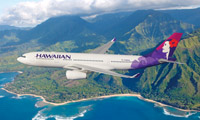Cover Story
ALOHA CHINA
Hawaiian Airlines will launch flights to China in April, but Mainland services are only part of a long-term plan to attract Asia-Pacific tourists to the island state.
February 1st 2014
For years, Hawaii has been high on the list of favoured destinations for the Japanese, yet for Chinese travelers it has hardly registered a blip on the holiday radar. But the picture is changing fast as big Chinese carriers jump into the market. Read More » Hawaiian Airlines chief executive, Mark Dunkerley, isn’t about to be left behind. With China Eastern Airlines already operating between from Shanghai and Honolulu and Air China flying from Beijing last month, Hawaiian will enter the Chinese market in April with a thrice-weekly service to Beijing.
 |
| 'China represents an opportunity of almost limitless dimension if indeed it meets its full potential' |
| Mark Dunkerley CEO Hawaiian Airlines |
“China represents an opportunity of almost limitless dimension if indeed it meets its full potential,” Dunkerley told Orient Aviation. “We always, in talking about China, strike an appropriate note of caution around the fact this is a non-proven route for Chinese visitors. A small number of Chinese visit Hawaii every year, but it is growing very quickly from a small base. If it becomes as large as it could be, it could be an enormous flow of visitors.”
Statistics reveal that last year Chinese visitors to Hawaii increased by 64% year-on-year, with travelers from Shanghai and Beijing accounting for more than 80% of the total, spurred by the launch of China Eastern services in late 2011.
Despite his caution, Dunkerley is excited by the longer term potential of the Mainland market and not only for flights to Beijing, Shanghai and Guangzhou. “I think they (Shanghai and Guangzhou) are very much on our list. But when we talk about the potential of China, clearly it would encompass not only the three principal cities in China, but more than a handful of some of the secondary cities which are enormous in their own right,” he said.
Also on the radar, once he receives planes that can do the distance, are destinations in a region Hawaiian hasn’t been able to serve - Southeast Asia. “We are extremely enthusiastic about Southeast Asia, but we don’t have the means of operating there today. The sector lengths are much longer than most people appreciate. It’s a 14 to 15 hour flight from Hawaii to Bangkok or Singapore,” Dunkerley said. That problem will be solved when the airline begins taking delivery of six of Airbus’ next-generation, carbon-composite A350s, beginning in 2017.
Neither is Dunkerley forgetting Greater China. In December, Hawaiian launched a codeshare program with Taiwan’s China Airlines that will significantly extend its regional network and allow members of frequent flyer programs to earn and redeem miles with both airlines. The agreement extends to inter-island flights within Hawaii. Hawaiian also has relationships in the Asia-Pacific with All Nippon Airways, Korean Air and Virgin Australia.
The carrier’s expansion in the Asia-pacific is a critical part of its future plans, taking it a crucial step away from the bankruptcy protection it was under from 2003 to 2005. Since then it has carefully rebuilt its operations and moved ahead with fleet refurbishment. The current fleet stands at 49: 14 A330-200s, 14 B767s, 18 B717s and three ATR turboprops. Apart from the A350s, the airline has ordered 16 A321neos with nine options, as well as seven A330s with five further options. The B767s will be gradually phased out and replaced by A330s. The neos will begin arriving in 2017 and be used principally for opening markets between neighbouring islands in Hawaii and destinations on the West Coast that can’t be served today because the wide-body is just too large.
Financially, too, the carrier is heading in the right direction after the trauma of bankruptcy. It posted a 2012 net income of $53.2 million, a marked improvement from the $2.6 million net loss it recorded in 2011. Last year, while it lost $17.1 million in the first quarter amid increased competition on U.S.-Mainland-Hawaii routes, in the second quarter it reported $11.3 million in profit, rising to $40.6 million in the third quarter. “If we take away the effects of the strengthening US$ from our results, the third quarter would have been the best three months in our company’s history,” said Dunkerley.
“If you look at the period since we’ve come out of bankruptcy, Hawaiian Airlines has been either the most profitable or second most profitable airline in the U.S.
 |
| Hawaiian’s first route to Mainland China starts in April, with an A330-200 three times a week |
“Our financial results have been much stronger than the industry as a whole, which has allowed us to expand and grow as we have done in Asia. We’ve maintained profitability through some very thin times, including the immediate wake of the global financial crisis when we were, in 2009, certainly the most profitable of all U.S. airlines.
“I would describe our financial situation as being good. Clearly, looking to the future it’s about making sure that substantial investment is made in Asia and earning the return we anticipate for our investors.”
There is good reason why Hawaiian – and other U.S. operators – are turning their attention increasingly to Asia. Hawaiian earns 47% of its passenger revenue from U.S. Mainland-Hawaii flights, 23% from services within the islands and the remaining 30% from Asia and Australasia. But the U.S. domestic market is mature and growth is slow. Competition and over-capacity are problems because Hawaii is served by every major U.S. carrier apart from Southwest.
“We have made no secret of the fact that our domestic business will grow quite slowly because flying between the islands of the State of Hawaii and flying between the U.S. and Hawaii are very mature markets, very well established and the populations of our travelers are pretty flat.
“So our domestic business will not grow very much and that contrasts with our view of the international business where you’ve got this rapidly expanding cohort of people in Asia whose incomes allow them to travel to overseas destinations,” says Dunkerley.
Outside of China, business in Asia is thriving, except the Philippines. Hawaiian pulled out of Manila last year because the route wasn’t providing adequate returns. It was a difficult decision for the airline’s chief. About a quarter of Hawaii’s residents have a Philippine background and family ties.
Japan, Hawaii’s major source of tourists in the region, is continuing to perform well. “Japan has been great for us. We had the happy timing of going into Japan when the Japanese Yen was extremely strong against the US$, making travel to Hawaii very affordable to Japanese. Also, Japan Airlines was having some difficulties and made important decisions to park their B747s and replace them with B767s. The consequence of these two circumstances meant it was a very fortuitous time to enter into the market. The Yen is devalued against the US$ by about 20% and we’ve seen JAL building capacity again, yet in the last two or three years our position in Japan has actually become stronger.” The airline flies to Tokyo (Haneda), Osaka, Fukuoka, Sapporo and Sendai. It has applied to the U.S. Department of Transportation to operate to Tokyo Haneda from Kona International Airport (on the Big Island).
“Our continued interest in additional rights underscores our confidence in Japan and our ability to prosper there, despite the strengthening of the US$ against the Yen in the last year,” Dunkerley said.
The carrier is cementing its footprint in Australia, where it has operated to Sydney since 2004 and Brisbane since late 2012. “In Australia we always look for opportunities to expand, but we are going to do so when conditions permit. We are operating daily from Sydney, sometimes 10 times a week depending on seasonality, and in Brisbane three times a week. We hope to raise these frequencies on a seasonal basis. You can expect our top priority is to grow Brisbane. Depending on how Australia shapes up, there may be opportunities for services to other destinations.”
Dunkerley has one other project under development - a new commuter airline, ‘Ohana by Hawaiian’, which will operate inter-island services using 48-seat ATR42s that are sitting idle. So far, he hasn’t been able to receive certification for the new operation from the Federal Aviation Administration (FAA). “The FAA said it doesn’t have the resources (money and personnel) to finish the certification work for ‘Ohana by Hawaiian,” explained Dunkerley.
“We don’t see the FAA saying the same things about the American and US Airways merger. We don’t see the FAA saying the same things about United operating a new aircraft type, the 787. We don’t see the FAA saying the same thing about American Airlines taking delivery of a new aircraft type. So, from our perspective, it seems pretty apparent that our needs have been put on the back burner vis-à-vis the other airlines, and that’s deeply frustrating,” said Dunkerley.
But he is upbeat. “We are bullish about the next twelve months. In our domestic business we see the environment improving. Having endured a year of double digit industry capacity growth we now have capacity decline. That’s going to improve our results on our domestic business. Turning to our international business, altering opening nine international routes in the last three years, we will be very focused on maturing them, particularly those we started in late 2011, 2012 and into 2013. We’ve got Beijing on the map so I think it will be an exciting year. I’d reiterate we are very bullish about the way 2014 is shaping up.”